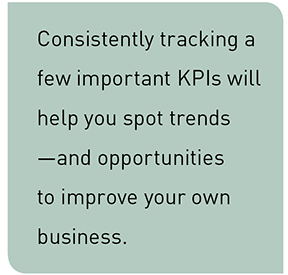HOME | ABOUT US | MEDIA KIT | CONTACT US | INQUIRE
HOME | ABOUT US | MEDIA KIT | CONTACT US | INQUIRE


Key Performance Indicators are measurements that can help you monitor the financial health of your business. When tracked consistently, KPIs help you make important decisions that affect your daily operations, growth and profitability.
A quick Google search reveals hundreds of KPIs, so your first task is to determine which ones are “key” to your business. Start by looking at your business goals and choosing KPIs that measure those goals specifically. Next, determine a target (such as current industry ratios) for each KPI and track your results against that target. This will help you monitor your performance and assess which areas of your business need the most attention.
Here are a few KPIs that are applicable to most industries:
Receivables Turnover:
For companies having issues with cash flow or collections, tracking this ratio over time will show whether sales are quickly being turned into cash. If receivables are not collected in a reasonable amount of time, cash flow will suffer. Used in conjunction with a receivables-aging schedule, the receivables turnover ratio will draw attention to overdue accounts that should be a priority for collection.

Inventory Turnover:
Using the same idea as receivables turnover, this ratio measures how long inventory is sitting on shelves before being sold. Ideally, inven-tory sits for a short amount of time before customers buy it. This ratio varies significantly across different industries, so be sure to use your own industry’s statistics with this KPI. If the turnover rate is significantly lower than the industry average, you may have too much invested in inventory.
Net Profit Margin:
This simple metric, when tracked consistently, can indicate sales trends throughout the year. If you only track net profit margin yearly or quarterly, you might be overlooking shorter seasonality trends that could be helpful with future forecasting and budgeting. Tracking this metric on a monthly or weekly basis can more clearly illuminate important trends.
Customer Loyalty:
What percentage of your sales are from repeat customers? While attracting new customers is crucial to profitability, customer retention is equally important to keep a strong sales base. When you are satisfied with your current ratio of new to repeat customers, make it a goal to maintain that ratio each year. Fluctuations will show whether you need to focus more attention on retention or new sales.
Customer Profitability:
If you can separate the costs of obtaining and servicing each customer, tracking customer profitability will help deter-mine the quality of customers. Investing inordinate amounts of time and money to retain a certain customer may indicate that your efforts could be better spent on attracting new customers to take their place.
Productivity Ratios:
Productivity ratios are most often used to analyze a company’s labor force. For example, a manufacturer will want to measure units produced per hour, while a service based business may look at the salaries they pay sales professionals as a percentage of sales. However, productivity ratios can be tailored to measure any aspect of a business by simply choosing an output and an input to measure.
Return on Investment:
Like product-ivity ratios, ROI can be applied to different business areas. Asset purchases, new products or inventory items can all be measured through ROI. If a gain can be attributed to a certain investment or purchase, ROI can be used. This ratio is helpful to determine if certain purchases were profitable and worth repeating. It can also be used to compare a class of pur-chases to clearly show the strongest option.
As you start to assess them, KPIs may seem overwhelming at first glance, but start with a handful and you’ll find the process is more manageable than you expected.
The “key” to successfully utilizing KPI’s is to choose the right ones for your business and track them regularly. By consistently monitoring a few important KPIs, you’ll spot trends and opportunities to improve. And you’ll know where to focus your attention to ensure your business measures up in the ways that matter most.